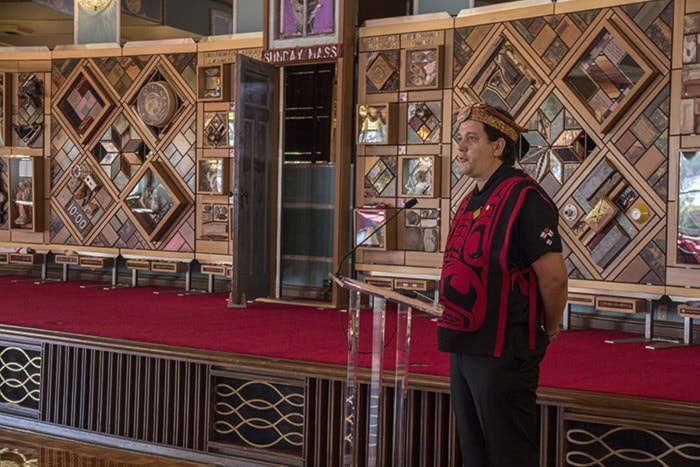By Jenn McGarrigle
A nationally recognized and thought-provoking contemporary art installation about the impacts of Canada’s Residential School era is coming to Vancouver Island University.
The Witness Blanket, created by First Nations artist and master carver Carey Newman, is a wood-based art installation made up of hundreds of items reclaimed from residential schools, churches, government buildings and traditional and cultural structures across Canada. The installation bears witness to one of the darkest chapters in Canada’s past. A past that, until recently, was not openly talked about or acknowledged. It is coming to VIU as part of the national cross-country tour of the blanket, which most recently was installed in Government House for the royal visit.
“Since we first launched the tour of the blanket in Victoria in 2014, the blanket has travelled thousands of kilometres to remote villages, townships and city centres across the country,” said Newman. “Our hope is people from every community, across the country, join us by standing witness to this important part of Canadian history. We, as a country, need to collectively honour the survivors, remember the children who were lost and find a better way forward.”
The Witness Blanket will be at The View Gallery at VIU’s Nanaimo campus from Thursday (Oct.6) until Nov. 30. An official opening reception will take place Oct. 6 at 6:30 p.m. in the Malaspina Theatre lobby. The public is invited to attend.
VIU partnered with the Regional District of Nanaimo on the application to bring the installation to Nanaimo, and the RDN has also supplied some of the funding. The university hopes it will create opportunities for the community to have conversations about this challenging but critical topic in Canadian history.
“As the subject matter is related to the education of First Nations peoples, it’s extremely important that the university hosts this piece, so that internal and external communities can learn about our past and about reconciliation – our future,” said Justin McGrail, a professor in VIU’s art and design department and curator of The View Gallery. “Art is the means for the conversation to happen. We’re hoping this installation will initiate multiple conversations about art, reconciliation and the residential schools era. This is the most significant thing we’ve shown in terms of the subject matter, the relationship to contemporary politics and interest across different demographics.”
McGrail hopes to see many relationships develop throughout the course of the show. To accompany the exhibit, VIU’s Office of Aboriginal Education is offering a workshop on reconciliation, called The Blanket Exercise, which leads participants through the history of treaty-making, colonization and resistance, using blankets to represent First Nations peoples living on the lands in what is now called Canada.
“The Blanket Exercise is a very visual and impactful learning opportunity for those who are interested in furthering their understanding of Canadian history from an aboriginal perspective,” said Sharon Hobenshield, VIU’s director of aboriginal education. “Residential Schools were a deliberate colonial tool for assimilation, but there were, and are, additional legislative structures that marginalize Aboriginal people. Uncovering these structures and having conversations is the work of educational institutions such as VIU.”
The Exercise, led by VIU’s Elders-in-Residence, will be offered to interested members of the public several times during the exhibition, and will continue on afterwards. To learn more and register go to http://bit.ly/2cRfDHL.
For many First Nations cultures, the blanket is a symbol of protection that identifies who people are and where they are from. They are worn during ceremonies and given as gifts. Inspired by a woven blanket, Newman and his team travelled across Canada in 2013 to meet with and gather artifacts from residential school survivors, families, churches and others with memories or relationships with residential schools.
The Witness Blanket, consisting of 13 wood panels, is more than 2.4 metres tall and 12 metres long. The more than 800 collected objects that are part of the installation include braids of hair, a Métis sash, a scale, a weather-beaten shoe, the door to the infirmary of St. Michael’s Residential School in Alert Bay and a stone from a community greenhouse in Inuvik. A multi-media presentation within the installation connects viewers to residential school experiences in a personal way.
Each piece has its own story to tell – stories of loss, strength, reconciliation and pride. Woven together into the Witness Blanket installation, they are a powerful, permanent reminder of the impacts of the Residential School era – the system created and run by churches and the Canadian government to “take the Indian out of the child.”
The Witness Blanket exhibit is part of VIU’s ongoing work around the topic of reconciliation with First Nations peoples. It also marks the start of Reconciliation Road: Join the Journey With VIU, a series of events that are part of VIU’s ongoing work in supporting the process and meeting the challenge of reconciliation. The events include the raising of a third totem at Shq’apthut, VIU’s Aboriginal Gathering Place; a concert with Buffy Sainte-Marie at the Port Theatre; the second annual Indigenous Speakers Series, a partnership with the Laurier Institution and CBC Radio One’s Ideas, which focuses on reconciliation and engagement with Canada’s Indigenous peoples; and Testify, which pairs lawyers and artists together to create an installation around the theme of reconciliation.
Jenn McGarrigle is a writer with VIU’s communications department.
